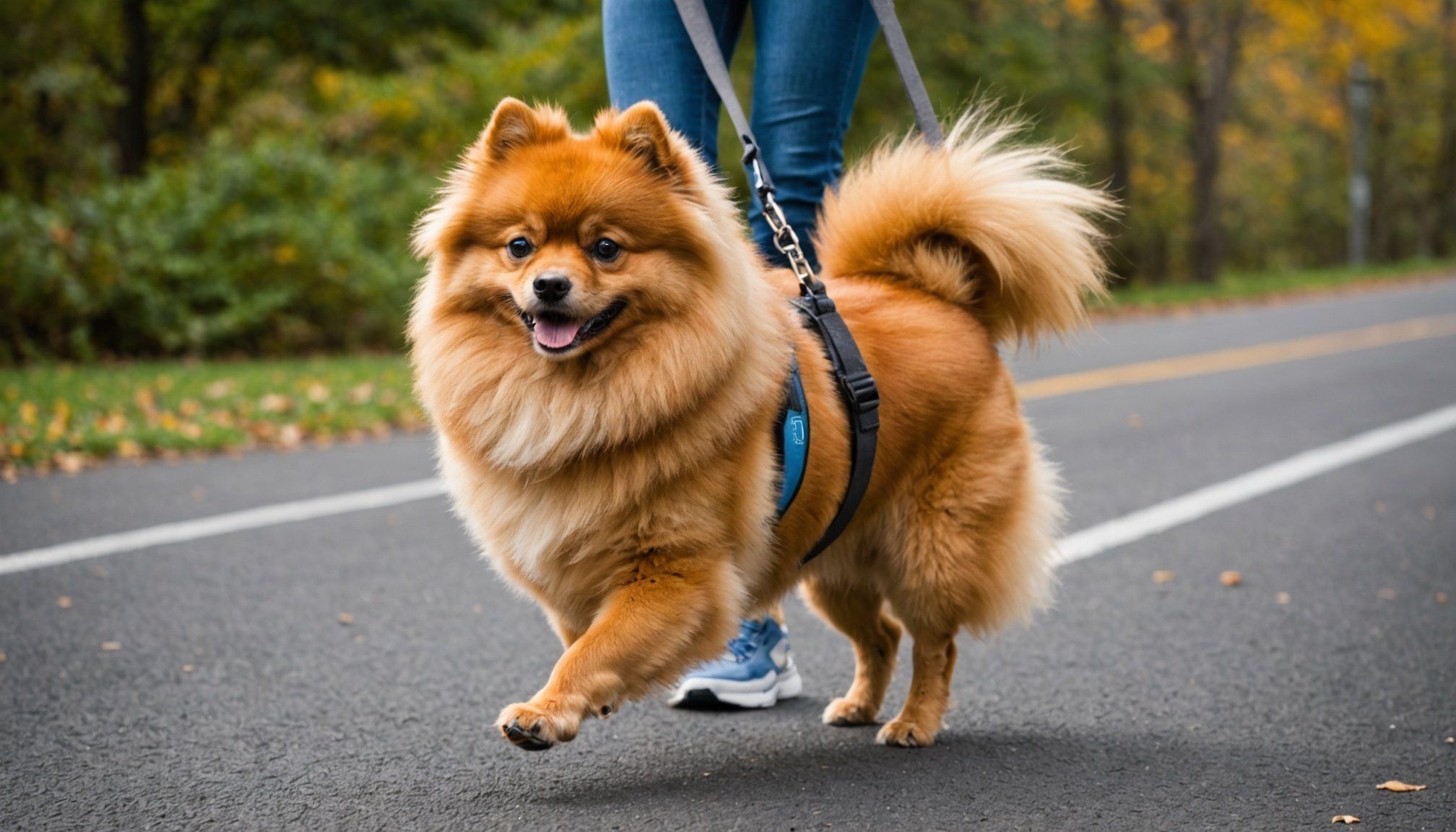Understanding Luxating Patella in Pomeranians
For Pomeranian health, luxating patella is a common knee joint issue. This condition involves the dislocation or shifting of the kneecap from its normal position, affecting the dog’s ability to walk normally. It’s primarily caused by genetic factors but can be exacerbated by trauma or excessive strain on the knee joint.
Recognizing the symptoms of luxating patella is crucial. Watch for signs like limping, skipping while walking, or resisting movement. These symptoms may occur intermittently or continually worsen over time, impacting your dog’s quality of life.
Topic to read : Must-Know First Aid Secrets for Pet Owners: Essential Tips to Keep Your Pets Safe!
Timely diagnosis and treatment play a vital role in managing Pomeranian health effectively. If left untreated, luxating patella can lead to arthritis and further joint degeneration. Veterinary intervention often includes physical examinations, X-rays, and sometimes blood tests to assess the severity.
Being proactive in addressing knee joint issues ensures a happier and healthier life for your pet. Treatment options range from lifestyle adjustments and exercises to surgical procedures in severe cases. Keeping your veterinarian in the loop is essential for crafting a management plan tailored to your dog’s needs. Remember, a well-informed approach can significantly alleviate the discomfort associated with this common Pomeranian health concern.
Topic to read : Top Tips to Stop and Tackle Fur Matting in Long-Haired Cats
Understanding Luxating Patella in Pomeranians
Luxating patella greatly impacts Pomeranian health, and understanding its nuances is crucial. Recognizing luxating patella—a condition where the kneecap dislocates—is vital for any Pomeranian owner. The condition is inherently influenced by genetic factors, making it a common knee joint issue in the breed.
Symptoms often present uniquely. Pomeranians might start limping, skipping steps, or show hesitation in movement. These signs aren’t always constant; they may appear suddenly and dissipate, potentially worsening over time. Hence, recognizing these changes promptly aids in managing the condition effectively.
Early diagnosis is essential. Unchecked luxating patella can escalate into arthritis, exacerbating knee joint issues. Veterinary procedures such as X-rays or physical exams are common steps to evaluate the problem’s severity. Suitable interventions might range from regular exercises to surgical procedures, depending on the severity.
Treatment is not one-size-fits-all. Lifestyle modifications play a significant role in management, ensuring a specialized approach caters to your Pomeranian’s unique needs. Regular communication with your veterinarian guarantees that your treatment plan is both responsive and tailored, promoting better joint health and quality of life for your beloved pet.
Tailored Exercise Routines for Pomeranians
For Pomeranians with luxating patella, customized fitness routines play a crucial role in managing symptoms and improving mobility. Crafting exercise routines that cater to the unique needs of these dogs can significantly enhance their quality of life, emphasizing both Pomeranian workouts and fitness plans.
Warm-Up Exercises
Proper warm-up exercises are essential before any Pomeranian workouts. A gradual warm-up helps reduce the risk of injury and prepares the muscles for activity. Slow, gentle stretching and a brisk walk around the yard can be perfect for getting started.
Low-Impact Activities
Low-impact activities form the cornerstone of effective fitness plans. Walking on soft surfaces and swimming are excellent choices. These activities minimize stress on the knee joints, making them ideal for Pomeranians with knee joint issues.
Strengthening Exercises
Strengthening exercises should focus on enhancing leg and core muscles to support joint stability. Simple activities like leg lifts and balance exercises can contribute to building strength. Implementing these into a Pomeranian’s fitness plan can help mitigate the effects of a luxating patella over time.
Understanding the specific needs of your Pomeranian and integrating tailored exercise routines is vital for maintaining their joint health and overall well-being.
Safety Tips for Exercise
When managing exercise safety for dogs with luxating patella, adhering to dog fitness precautions is crucial in preventing injury. Exercise safety begins with understanding the boundaries of your dog’s comfort levels and adjusting workouts accordingly. Always observe signs of discomfort or fatigue during exercise sessions.
Monitoring your dog’s comfort involves keeping an eye on their movements and behaviour. If they start limping or show resistance, it’s vital to stop the activity and assess their condition. End exercise immediately if symptoms of distress appear.
Using appropriate gear and equipment is another key aspect of injury prevention. Ensuring that harnesses and leashes are properly fitted reduces unnecessary strain on the knee joints. Consider using padded surfaces for indoor exercises to cushion impacts, and choose soft terrains like grass for outdoor activities.
Regular breaks allow your Pom to rest, reducing the potential for strain. Consistently warm up beforehand and cool down afterward to ease transitions into different intensity levels. Incorporating these precautions not only keeps your Pomeranian safe but also promotes mobility improvement over time. By prioritizing safety, you ensure your dog’s fitness plan is effective and prevents setbacks.
Weight Management Strategies
Maintaining a healthy weight is crucial in alleviating the symptoms of luxating patella in Pomeranians, as excess weight places additional stress on their delicate knee joints. Effective weight management can slow the progression of this condition and enhance overall well-being.
Regularly monitoring your dog’s weight is the first step in obesity prevention. Utilize a dog fitness plan that emphasizes both dietary adjustments and appropriate exercise. Incorporate lean proteins and fibers into your Pomeranian’s diet. Avoid overfeeding and limit treats high in sugar and fat to support weight control.
Dietary adjustments play a vital role alongside exercise. Opt for high-quality, low-calorie dog food to ensure they are receiving the right nutrients without unnecessary calories. Consult with your veterinarian for personalized diet plans that cater to your Pomeranian’s specific needs.
Utilize techniques like portion control and scheduled feeding to maintain a consistent weight. Regular weigh-ins and body condition assessments can provide insight into your dog’s health trajectory.
By implementing these strategies, you not only address knee joint issues but also promote long-term joint stability and mobility improvements. Tailoring these strategies to your dog’s lifestyle ensures a sustainable approach to managing their condition.
Veterinary Recommendations and Support
Ensuring optimal Pomeranian health requires regular consultations with dog health experts. Engaging in professional consultations helps owners navigate luxating patella challenges effectively. Veterinarians offer invaluable guidance by conducting regular health check-ups, crucial for early detection of knee joint issues. Monitoring your dog’s condition allows timely diagnosis and enhances treatment efficacy.
When should you consult a veterinarian? As soon as signs of discomfort—such as limping or skipping—appear, a timely appointment can prevent further complications. Beyond this, a dog health expert may recommend pet physiotherapy, focusing on tailored exercise routines to improve mobility.
Veterinary advice often extends to recommending specific supplements or therapies. Nutritional supplements may strengthen cartilage and support joint stability. Professionals tailor these recommendations based on your Pomeranian’s unique needs, ensuring a holistic approach to health.
Collaborating with both veterinarians and, if needed, a pet physiotherapist, guarantees a comprehensive strategy for managing your pet’s condition. By integrating professional guidance with preventive care, you proactively address knee joint issues, ensuring your dog’s well-being and longevity.
Seek regular check-ups and consider professional consultations as part of a well-rounded care plan for your Pomeranian.
Success Stories and Case Studies
Exploring dog success stories offers inspiration and insight into fitness recovery for Pomeranians with luxating patella. Real-life examples showcase how tailored exercise routines can play a pivotal role in enhancing mobility and overall health. Many Pomeranian owners have witnessed transformative changes in their pets through customized fitness plans and consistent effort.
In one notable instance, a Pomeranian named Bella regained her agility and comfort after engaging in a structured exercise regime. Focusing on low-impact activities and strengthening exercises, Bella’s owner observed a marked reduction in limping and increased playfulness. This example underscores how tailored exercise routines support joint stability and elevate a dog’s quality of life.
Case studies also highlight effective strategies, such as collaborative efforts between veterinarians and trainers. These partnerships often employ a holistic approach, integrating veterinary advice with practical dog exercise plans. Trainers focus on balancing activities; ensuring exercises neither stress joints nor compromise safety.
Insights from these cases emphasize the importance of persistence and customization. Sharing experiences enriches the community’s understanding, empowering more pet owners to seek adaptive solutions. With the right approach, Pomeranians can lead healthier, more active lives, even when faced with joint challenges.







